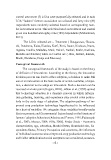Page 671 - 2015-37
P. 671
control area seven (7) LGAs were purposefully selected and in each
LGA “fadama” farmers association are selected and forty nine (49)
respondents were randomly selected based on corresponding num-
ber in treatment areas. This selection based on treatment and control
gives one hundred and eighty nine (189) respondents (Mohammed,
2013).
The LGAs selected are :- Treatment ( Batagarawa, Charan-
chi, Dutsinma, Kaita, Katsina, Kuri, Rimi, Baure, Bindawa, Daura,
Ingawa, Kankia, Maiadua, Mani, Bakori, Faskari, Kafur, Kankara,
Matazu and Sabuwa) while in Control are ( Jibia, Batsari, Kusada,
Mashi, Dandume, Danja and Musawa).
Conceptual framework
The conceptual framework of the study is based on the theory
of diffusion of innovations. According to the theory, the innovation
decision process can lead to either adoption, a decision to make full
use of an innovation as the best course of action available, or rejec-
tion, a decision not to adopt an innovation. Such a decision can be
reversed at a later point (Rogers, 2003). Jabbar et al. (1998) opined
that technology adoption is a dynamic process in which informa-
tion gathering, learning, and experience play pivotal roles particu-
larly in the early stage of adoption. The adoption pathway of im-
proved crop production technology hypothesised to be inluenced
by a host of variables. We categorise these variables broadly under
Socio-economic and Governmental factors based on the literature of
farmers’ adoption behaviour (Adesina and Forson, 1995; Pattanayak
et al., 2003; Mercer, 2004; Ellis, 2006). Under Socio - Economic
characteristics, age, education, Marital Status, Household size, Re-
spondents Status, Primary Occupation and awareness, the inluences
of individual awareness about improved crop production technology
and his/her attitude about social acceptance are considered, as aware-
-6-

